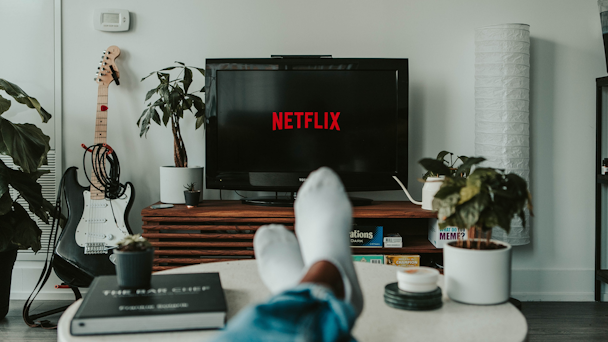New Netflix ad formats, including sponsorships and QR codes, create opportunity and risk
The streaming platform plans to use ultra-popular programs such as Squid Game and The Crown to attract more advertising dollars while also introducing lower-funnel, interactive formats. But the competition remains fierce.

Netflix is rolling out a range of new ad formats / Mollie Sivaram
A year after Netflix introduced a variety of new service plans, including a free, ad-supported tier, the streaming giant is venturing deeper into the advertising-based video-on-demand (AVOD) space with a slate of new ad offerings.
In a blog post published on Wednesday, Netflix’s newly-appointed president of advertising, Amy Reinhard, said that the company’s ad-supported tier, which has gained around 15 million subscribers, will welcome a handful of new ad formats. Following the success of Frito Lay’s Smartfood sponsorship of the latest season of the popular reality dating program Love is Blind, the platform will now allow brands to sponsor popular Netflix shows.
Reinhard says it expects to pick up sponsor dollars for forthcoming seasons of the new reality program Squid Game: The Challenge as well as the final season of The Crown. “We want to shape the future of advertising on Netflix and help marketers tap into the amazing fandom generated by our must-watch shows and movies,” she wrote.
Advertisement
Beyond new sponsorship options, Netflix is also rolling out features that include QR codes embedded in US Netflix programming as well as a ‘binge ad (wt)’ format, which incentivizes binge streaming by giving viewers an ad-free episode after streaming three episodes back-to-back. The ‘binge ad (wt)’ offering will be available to media buyers globally beginning in the first quarter of 2024. Further, brands can now opt to run 10-, 20- or 60-second spots in addition to existing 15- and 30-second options.
Reinhard also said that Netflix plans to expand its media measurement capabilities globally – it’s looking to partner with additional third-party ad verification providers in the coming year. The development would add to additional efforts that the platform has made in the last year to improve measurement insights for media buyers, including teaming up with Integral Ad Science and DoubleVerify on ad verification in markets around the world and introducing Nielsen’s cross-measurement framework Nielsen One in the US.
Netflix is also promising more perks for subscribers on its ad-supported tier. Over the last year, it has offered these subscribers higher-quality video, enabled two concurrent streams and, by the end of this week, will allow downloads of both TV shows and movies.
Advertisement
Media experts say the news indicates an ongoing sea change as consumers express growing interest in more affordable ad-free subscription options.
As Lauri Baker, senior vice-president of partnerships at video adtech firm Infillion, puts it: “Netflix’s surge in ad-supported subscribers highlights a significant consumer shift from expensive subscriptions to more cost-effective TV options … it’s a deliberate response to industry trends.”
Other leaders in the space echo this sentiment. “Netflix’s ad-supported model is just one piece of a broader paradigm shift across the streaming industry, as platforms shift their focus from overall user growth to profitability,” explains Curt Larson, chief product officer at independent ad exchange Sharethrough.
In Larson’s view, the Netflix of yesteryear was “suffering a death by a thousand cuts,” seeing growth slow and competition increase as audiences fragmented across platforms.
Now, he says, the company has a chance to win back some of the ground it may have lost: “By offering ad-supported plans and more options to access their content, streaming service providers can diversify their sources of revenue and enhance profitability while also reducing subscriber churn.”
Plus, Netflix “sets a good example of how to balance the interests of advertisers and viewers while upholding a high standard of viewer experience” with new ad formats that minimize disruption, says Baker.
Suggested newsletters for you
Despite Netflix’s apparent success in its first year in the AVOD market, it’s still a relative newcomer, having focused for years solely on ad-free premium subscriptions. In fact, according to Jeremy Haft, chief revenue officer at performance marketing firm Digital Remedy, the company is “playing a bit of catch up.” Competitors in the space like Warner Bros Discovery’s Max, Hulu and YouTube have already been offering some of Netflix’s new performance-focused ad capabilities – like QR codes and shoppable, interactive formats – for some time.
“Netflix’s nascent ad-supported offering needs to remain competitive as more streamers are entering the ad-supported game and developing new, innovative formats native to a TV consumption model that’s entirely digital,” Haft says.
Furthermore, as Netflix attempts to straddle the full marketing funnel – with high-level brand-building opportunities like longer-form ads and title sponsorships as well as lower-funnel performance offerings like QR codes, the company may “find itself in a Catch 22,” according to Michael Goldstein, head of communications strategy at DDB North America.
Goldstein says that Netflix initially positioned itself as a premium, “TV-like” environment where only a handful of brands could afford to play next to premium content. Now, with lower-funnel and performance marketing offerings, Netflix won’t be able to charge a premium across the board, as it welcomes ad spend from a greater variety of brands.
“Netflix has a unique challenge: How do they satisfy the need for measurable, innovative ad formats without degrading the premium contexts that drive advertisers there in the first place? 15 million subscribers is nice, but it’s not mass enough to satisfy straight reach goals for advertisers,” says Goldstein.
Nonetheless, experts are generally bullish on Netflix’s continued success in AVOD. And Netflix’s investment in ad-supported streaming, they say, underscores the broader direction of the connected TV industry.
“As consumers’ ad-tolerance remains high across all cohorts, we will continue to see an increase in the roll-out of ad-supported tiers,” says Scott Maddux, vice-president of global content strategy and business at Xperi. “The most recent TiVo [data] found that 27.3% of Netflix’s subscribers use an ad-supported tier, and given the broader trends we’ve seen with other subscription video-on-demand services like Peacock and Hulu whose ad tiers usage has grown year-over-year, we expect that there will be even more growth in popularity with ad-supported tiers over the coming months and year.”
For more, sign up for The Drum’s daily newsletter here.

